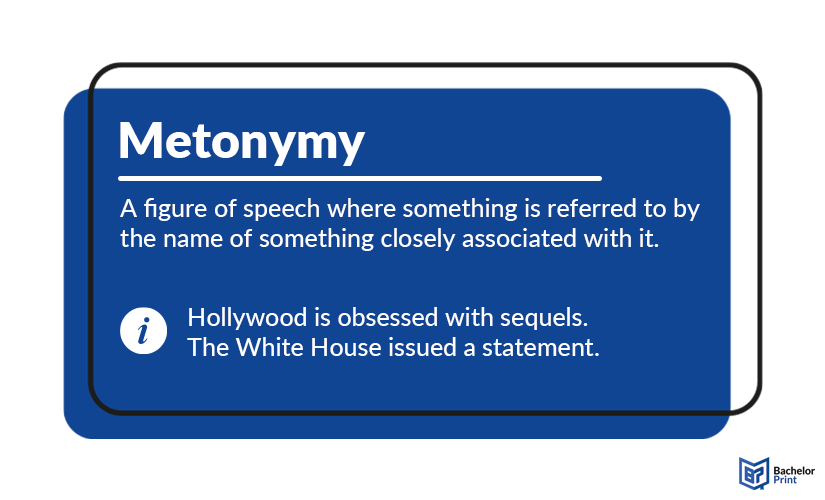
In the realm of linguistic analysis, it is important to keep things brief. However, at times, a straightforward sentence may not suffice. Metonymy is a rhetorical device in which one word or phrase is substituted with another that has a close associative with it. It allows speakers and writers to convey complex ideas or evoke specific images or emotions by using related terms. So, lend me your ears – this article will shed a light on how to use this stylistic device in academic writing.
Definition: Metonymy
Metonymy refers to a rhetorical device where a word or phrase is replaced with a word or phrase closely related to it, typically based on a shared attribute, context, or association. This substitution is based on a conceptual or contextual relationship between the two words or phrases, rather than a direct similarity or comparison. It is a rhetorical device used to convey a specific meaning or create an effect by invoking something related rather than directly stating it. This stylistic device is typically used in everyday speech to enhance the richness and expressiveness of language.

in Your Thesis
Types of metonymy
In the realm of literary and rhetorical analysis, while “metonymy” stands as a distinctive term with limited synonyms, there are several concepts that encompass facets of metonymical language or function in comparable manners. These types encompass:
- Allegory
- Analogy
- Euphemism
- Metaphor
- Oxymoron
- Personification
- Rhetorical devices
- Synecdoche
Note: Although the terms have some commonality and may overlap in certain contexts, they are not strictly synonymous with the device itself. The latter retains its definition and application.
Metonymy vs. synecdoche
Both figures of speech involve substituting one word or phrase for another, but they differ in their specific mechanism of substitution and focus on distinct aspects of the relationship between words. Both figures add depth and nuance to language by using substitutions to create meaning and convey ideas in different ways.
- In Metonymy, only one word or phrase is substituted with another word based on a broader or more associative context or common usage. The words don’t have to be interchangeable.
- In Synecdoche, a part of something is used to represent the whole or the whole is used to represent a part. It involves a more specific relationship between the terms.
Metonymy vs. metalepsis
Both stylistic devices are used in language to convey meaning beyond their literal interpretations, but they operate in slightly different ways:
- Metonymy is used to make language more concise, vivid, or expressive by using a word or phrase that evokes the intended concept or idea.
- Metalepsis is a more complex and less common figure of speech in which one word is substituted with another. The substitution, however, occurs through a series of related terms, often resulting in a recursive or self-referential effect. It can lead to a sense of surreal or dreamlike language, as it blurs the boundaries between different levels of meaning and reality.
Metonymy vs. metaphor
Both stylistic devices are used to make language more vivid and expressive, but they serve different rhetorical purposes, as in the following:
Commonly used metonymy examples
Metonymy is a figure of speech frequently employed in both everyday language and literary works. Below, you’ll find commonly used metonymy examples that showcase how this stylistic device enriches our communication by suggesting more in-depth meanings and associations with just a few carefully chosen words.
Metonymy in academic writing
Many students might use metonymy subconsciously in daily conversation, but authors intentionally utilize it in novels, essays, and poems for various purposes. However, In academic writing it is crucial to ensure that the content is credible, clear, and suitable for a scholarly audience. Metonymy is characterized mainly by the fact that they use a word to paraphrase something to create a specific meaning. As a result, they lose objectivity and neutrality. Therefore, you should generally avoid the use of metonymy in academic papers. Moreover, you should pay attention to the style guide of your academic institution and examiner.
- ✓ Free express delivery
- ✓ Individual embossing
- ✓ Selection of high-quality bindings
Etymology
The word “metonymy” has its origins in ancient Greek. It comes from the word “metōnymia”, which is a combination of two words:
- “Meta”: This Greek prefix means “beyond” or “change”
- “Onyma”: This term means “name” or “word”
When combined, “metōnymia” roughly translates to “change of name”. This Etymology reflects the essence of this rhetorical device, where one word or phrase is changed with another, based on their contextual or associative relationship.
FAQs
It is a figure of speech where a word or phrase is replaced by another word or phrase closely associated with it. Instead of saying the actual thing, you say something related to it, which allows people to understand what you are referring to.
An example for a metonymy could be: “The White House issued a statement on the matter.”
“The White House” refers to the President or the executive branch of the US government.
To use this rhetorical device effectively, consider the context and association between the substituted terms. Ensure that the term is clear and enhances the reader’s understanding without causing confusion.
The main difference lies in how these figures of speech create meaning. Metonymy relies on association and substitution based on a contextual or conceptual link, whereas metaphors rely on direct and imaginative comparisons between unrelated things.
Metonymy: only one term is substituted with another related word
Synecdoche: substituting a part for the whole (or vice versa)
